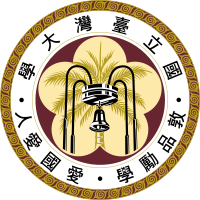【宏觀視野】A French Researcher in Taiwan(9th january-9th february 2015)

Stéphanie Smadja
CERILAC, University Paris Diderot
Senior Lecturer in the Department of Lettres, Art, Cinéma at the University Paris Diderot - Paris 7, since 2008, I teach Stylistics and French Linguistics. I was the Associate Director of the department from september 2011 to October 2014 and I am member of the governing council of the Humanities Institute of Paris, since may 2011. In this Institute, I am responsible for the International Affairs and the pedagogic projects. I have published in 2013 a book about The New French Prose during the twenties (La « Nouvelle Prose française ». Étude sur la prose narrative au début des années 1920, Bordeaux, Presses Universitaires de Bordeaux, Poétique et stylistique, 2013). Another monograph has been accepted and will be published in 2015 about the History of French Literary Prose in novels, poetry and essay from 1850 to 1950 (Cent ans de prose française 1850-1950. Invention et évolution d’une catégorie esthétique, Paris, Garnier, Investigations stylistiques).
The Humanities Institute of Paris is part of two main consortiums, ECHIC (European Consortium for Humanities Institutes and Centers, http://echic.org/) and CHCI (Consortium of Humanities Centers and Institutes, http://chcinetwork.org/). Established in 1988, the Consortium of Humanities Centers and Institutes is an international organization headquartered at the John Hope Franklin Humanities Institute at Duke University. The European Consortium for Humanities Institutes and Centers is a university-based initiative to organise European Research Institutes, Humanities Faculties and Centers for the Humanities. They both are networks for the circulation of information, ideas, and best practices.
I have met Professor Kirill Thompson during the founding conference of ECHIC (Dublin, february 2011). He was invited by the Humanities Institute of Paris for a month in september 2012. Among other things, he contributes to the first international symposium for my Monologue project. I was invited as a visiting fellow by Dean Huang and Vice-Dean Thompson, at the Institute of Advanced Studies for Humanities and Social Sciences in the National University of Taiwan, from the 9th of January to the 9th of February. I really would like to express my deep gratitude to them and to all the staff of the Institute, for the amazing organization and the so warm welcome. I would like also to thank the Office of International Affairs of NTU.
Founded by the Japanese during the occupation, NTU is the first University in Taiwan, and one of the best in China. All fields are represented, from medicine to exact sciences, social sciences and humanities. The library offers an impressive number of monographs, collective books, and literature. It offers also the biggest collection of western books in China. The international policy is very active, and very effective. I first came in Taiwan for the UBIAS Directors Conference (http://www.ubias.net/), in the Institute of Advanced Studies, in November 2014. As I have said, even if I am not the Director, I represent my Institute in such meetings abroad. I have already found the organization amazing then, and I still have that impression. This stay is only my second in Taiwan, but if I can, I will come back. I am definitely fond of the culture (the Palace Museum is one of the greatest Museum I have ever seen), the way of working, the hospitality (remarkable), and the kindness.
During my stay, I have been working on two scientific projects. Since 2010, I am the manager of an Idex project Monologue : situations, forms and practices. This project implies a reflexion on identity, subjectivity but also language and communication. Since 2013, I am the co-manager of a project about Science and common language. Firmly interdisciplinary, this program explores the relations between science, public space and common language from the 19th century, when the divorce begun between science and literature, until today. Since 2014, I am the manager of a project Style of science, related to the previous one. For the Monologue Project, I have completed here the first version of my habilitation monograph (the equivalent of the promotion monograph in Taiwan), Monologue in French Prose. It is still a work in progress, but I will be able to present it soon. I am very grateful, for that, to Dean Huang and Vice-Dean Thompson.
During my stay in Taiwan, for the Monologue and the Style projects, I have tried to create connections (NTU, Academia Sinica, NCU, Mazaryk University, University of Art), so that we could build a cooperation network. The socio-cultural differences, the specificity of language and the habits would be very significant for both projects.
1- Monologue, Self-Talk and Inner Speech
I have started the interdisciplinary project Monologue, Self-Talk and Inner Speech, the 12th of October 2010, with a lecture on the Invention of Interior Monologue in France. It was first a seminar related to the research team of the Department of Letters Art and Cinema, CERILAC, and the Humanities Institute of Paris. Within the Institute, the Monologue Project was one of the two first laboratories and exploratory programs. The Monologue Project has been selected for the first Idex Call in Sorbonne Paris Cité in 2012 (Stéphanie Smadja, University Paris Diderot / Aliyah Morgenstern, University Sorbonne Nouvelle), for a three years funding. In the research team there are 18 members and partners. Since 2013, Evelyne Lignon began a PHD about Monologue and Polyphony (supervision : Aliyah Morgenstern and Stéphanie Smadja). Two others students will begin a PHD in 2015 (supervision : Stéphanie Smadja), and they already are very active members of the team.
Our purpose is to work on all kinds of monologues, including inner speech and self-talk. We would like to compare literary monologues, and real life monologues. We have started in 2010 with some questions. What is exactly a ‘ monologue' ? How does it appear ? From the theater monologue to the self- talk of insane or dying people, from the interior monologue to the practices of children, are there differences, similarities ? Can we find common criteria of definition ? Moreover, what does a monologue tell us about the human condition, the self-representation, the use of language and the relationships with others ?
According to Anders Holmberg, 'self-talk, also called intrapersonal communication or inner dialogue' is 'a phenomenon which, as far as I have been able to determine, has not previously been given any attention within linguistic theory'. We can expand on his assertion. Monologues have never been studied within an interdisciplinary method and the field of research is huge.
This project implies a reflexion on identity, subjectivity but also language and communication. Four main lines were defined during the first meeting, in 2010 :
- Construction and deconstruction of self-representation ;
- Link between monologue and dialogue ;
- Link between monologue and humanity ;
- Study of those who produce monologues, including madmen, seriously ill and homeless person.
At the moment, we are intending to create a corpus of real-life monologues and self-talks for further linguistic, semiotic, psychological and anthropological analysis. But, our method is partially based on a comparison between literary monologues and real-life monologues.
Working on monologues could bring us to a redefinition of various categories like madness, marginality, according to a logic that would not be manichean but adapted to the free mobility of life. For instance, madmen do not belong to a strange country beyond humanity ; they are a part of humanity. The question of self-talk may lead us to think in a different way about human representation and taking care of suffering in a society that tends to refuse differences, that is to say, human nature. Redefine humanity, redefine society and link the two notions together : that could be the horizon of the project.
The Monologue Project, in few words (february 2015) :
A scientific challenge : Monologue, Self-talk and inner speech ;
A team of 18 researchers, PHD students and partners ;
1 international symposium in 2012, 2 more in the coming months;
12 workshops ;
25 working sessions for the research seminar (French and english literature, theater, stylistics, linguistics, medecine, cognitive psychology, psychoanalysis, didactics, neurosciences, writers, stage director) ;
An epistemological reflexion and a real interdisciplinary practice (17 disciplines represented) ;
Innovative experiment, since 2015 ;
Art-research project ;
Implications in civil society and societal challenges ;
A starting international policy (France-Taiwan cooperation project) ;
Plans for fundings.
2- Style of science
The project Style of Science was first an interdisciplinary programm on Science in common language, co-managed by Paule Petitier (Professor of French Literature, specialist of Literature and History, University Paris Diderot) and Stéphanie Smadja. A seminar and several worshops were organized, on the behalf of the J. Seebacher ressources Center (specialized in the xixth century), and the Institute of Humanities. In 2014, we have decided to focus our reflections on Style. This project involves french researchers (University Paris 3, Paris V, Paris 7 and Paris 13), but also foreign researchers (Canada, Switzerland, Germany, United States). A student will begin a PHD in 2015 (supervision : Stéphanie Smadja).
If style and science seem to have little in common nowadays, this apparent split is more recent than one may think. It is only during the XIXth century, when human sciences emerge and literature begins to be autonomous and to set itself apart from the common language, that Style is claimed to be a specific component to literature. What is Style ? However fundamental this notion may be in a number of disciplines (stylistics, literature and art history), it remains difficult to define. Such as literature, the notion of Style has rhetorical origins. Its definition is both broad (as it applies to both to the ways of living as well as the works of art) and very narrow when it comes to written works. Nowadays, most often one thinks of the “author’s style” when this notion is used regarding a literary production. Just like stylistics experienced a drop in popularity, Style – as the main subject of stylistics – did as well and is now making a comeback through controversial definitions. Indeed, the recent reflections on Style experience difficulties agreeing on one common definition. Furthermore, according to Anne Herschberg Pierrot, “We no longer talk about Style in literature […] it appears that Style is not a major concern in literary stylistics whereas in the arts, Style is being studied independently from stylistics” (Le Style en mouvement. Littérature et art, Paris, Belin, 2005, p. 3). As such, Style is not only resisting any attempt of being defined, but some critics steer away from it even in disciplines where it should hold a central position. This question becomes even more complicated if we broaden our thought beyond literature, stylistics and art history. How can Style be defined from an interdisciplinary standpoint ? What is Style, not only to literature and arts but also to mathematics, physics, etc. ? How can the notion of Style be grasped after the emergence of human sciences and the split between literary and common language ? What tools do we have to analyse the notion of Style (scientific written works as well as demonstrations by example) from the XVIIIth century until today ? We will see that the questions at stake vary from century to century, and sometimes even from decade to decade. We will therefore vary the angles of analysis in order to investigate on the Styles of science. We will base our analysis on key time periods (beginning with the XIXth century and the 1920s), on specific disciplines (what is Style in stylistics or literature ? In history ? In mathematics ? In history of sciences ? In psychoanalysis ?), and on authors (Michelet, Lacan, etc.).
The globalization of science from the XIXth to the XXIst century would make irrelevant a project that is limited only to France. The issue we are pointing out derives from the general evolution of sciences and its relation with what’s common (common men, common language, and human community). Style is often thought of outside of what is common. However, at a time when language and literature are considered to be the expression of nationalities, to think about the transmission of science in the context of linguistic expression assumes that historical and cultural specificities are taken into account. From France to the United States, England to Germany and Russia, Europe to Asia, different types of societies, institutional frameworks and political contexts will allow the formulation of a general subject matter.
This project questions the structuring of knowledge and cultures, their elaboration and transmission through language as well as their patrimonial implications. What is at stake here is not only the question of transmission but also the relationship to language and to identity (cultural, national or individual). In reality, this entirely cross-cutting notion is meant to reflect upon history in order to better reflect upon what is contemporary. We can talk about literary or artistic style just as much as the style of mathematics or life style.
These two projects are an example (and an experiment) of possible realization for a humanities and social sciences laboratory. Such a laboratory should expand at an international level, beginning with Taiwan for the monologue project. The multiple representations of Self in Asian traditions are very different from the european representations. The language gives us a significat clue of that : there is only one word in french for Self “le soi”, whereas there are many in chinese (relational self etc.). Sure, we will also find similarities, as we are trying in fact to answer one common question : what is it, to be human ? What is, deeply inside, humanity ?



